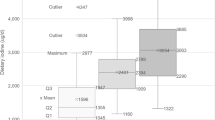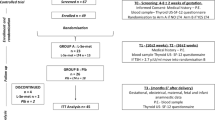Abstract
Fish consumption or supplementation with omega-3 fatty acids was reported to cure and/or prevent autoimmune and nonautoimmune disorders. Serum positivity for thyroid autoantibodies is a predictive marker of postpartum thyroiditis and postpartum depression. We hypothesized that stable consumption of the omega-3-rich oily fish was associated with a more favorable profile of serum thyroid antibodies throughout pregnancy and early postpartum compared with stable consumption of swordfish, a predator that concentrates pollutants. We prospectively measured serum thyroglobulin antibodies and thyroperoxidase antibodies in pregnancy (first, second trimesters) and postpartum (day 4), in 236 thyroid disease-free, nonsmoker Caucasian women with stable dietary habits. We did not measure thyroid autoantibodies prior to pregnancy. Women were divided into groups A (n = 48; swordfish), B (n = 52; oily fish), C (n = 68; swordfish + other fish, not necessarily oily fish), and D (n = 68; fish other than swordfish and oily fish). Major endpoints were positivity rates and serum concentrations of the two autoantibodies. We resorted to previous studies for the estimated content of fatty acids and microelements in the consumed fish. Positivity rates and serum concentrations of both antibodies were the greatest in group A and the lowest in group B (P < 0.001 and P < 0.05 to < 0.001, respectively). Relationship between monthly fish consumption and serum concentrations of either antibody was direct in group A but inverse in group B. The estimated content of omega-3 fatty acids in fish consumed by group B was the greatest (P < 0.001 vs. any other group). These data reinforce recommendations that pregnant women should avoid consuming swordfish and indicate consumption of oily fish as a favorable alternative. Because thyroid autoantibodies are markers of autoimmune-related postpartum problems, our data suggest a dietary prophylaxis of such problems.


Similar content being viewed by others
References
V. Molina, M. Ehrenfeld, 2003 Environmental factors in autoimmune diseases workshop. Autoimm. Rev. 2, 284–289 (2003)
G. Carmi, H. Amital, The geoepidemiology of autoimmunity: capsules from the 7th International Congress on Autoimmunity, Ljubljana, Slovenia, March 2010. Isr. Med. Assoc. J. 13, 121–127 (2011)
M. Tajtáková, Z. Semanová, Z. Tomková, E. Szökeová, J. Majoros, Z. Rádiková, E. Seböková, I. Klimes, P. Langer, Increased thyroid volume and frequency of thyroid disorders signs in schoolchildren from nitrate polluted area. Chemosphere 62, 559–564 (2006)
Z. Rádiková, M. Tajtáková, A. Kocan, T. Trnovec, E. Seböková, I. Klimes, P. Langer, Possible effects of environmental nitrates and toxic organochlorines on human thyroid in highly polluted areas in Slovakia. Thyroid 18, 353–362 (2008)
L.M. Schell, M.V. Gallo, J. Ravenscroft, A.P. DeCaprio, Persistent organic pollutants and anti-thyroid peroxidase levels in Akwesasne Mohawk young adults. Environ. Res. 109, 86–92 (2009)
The land that brought you raw fish Is saying no to seafood http://online.wsj.com/article/SB10001424052748703775504575135952519129266.html. Accessed 27 Apr 2015
U.S. Seafood Consumption Declines Slightly in 2009 http://www.noaanews.noaa.gov/stories2010/20100909_consumption.html. Accessed 27 Apr 2015
http://www.pubblicitaitalia.com/ilpesce/2009/4/9114.html. Accessed 27 Apr 2015
Stohs S. U.S. and International Commercial Swordfish Fishery Background, and the Futility of Unilateral Conservation. January 2011. http://cmbc.ucsd.edu/Students/Current_Students/MCBP/Stohs%20Economics.pdf. Accessed 27 Apr 2015
M.C. Fossi, S. Casini, L. Marsili, A. Ausili, G.N. di Sciara, Are the Mediterranean top predators exposed to toxicological risk due to endocrine disrupters? Ann. NY Acad. Sci. 948, 67–74 (2001)
M.C. Fossi, S. Casini, L. Marsili, S. Ancora, G. Mori, G. Neri, T. Romeo, A. Ausili, Evaluation of ecotoxicological effects of endocrine disrupters during a four-year survey of the Mediterranean population of swordfish (Xiphias gladius). Mar. Environ. Res. 58, 425–429 (2004)
Genovese, L., Modica, A. Ricerca di contaminanti chimici in tessuti di pesci provenienti dallo Stretto di Messina e da impianti di maricoltura siti nella provincia di Messina-Relazione Finale. Progetto “ITTIOS” Promozione prodotti della pesca e dell’acquacoltura dell’area della provincia di Messina e azioni di supporto alle aziende di produzione dei prodotti ittici per la certificazione di qualità. P.O.R. Sicilia 2000-2006. Report per Consiglio Nazionale delle Ricerche, 2007. www.provincia.messina.it/ittios/pubblicazioni/contaminanti.pdf. Accessed 30 Oct 2013.
Mercury Levels in Commercial Fish and Shellfish (1990-2010) http://www.fda.gov/food/foodborneillnesscontaminants/metals/ucm115644.htmAccessed 2 Apr 2015
C.M. Gallagher, J.R. Meliker, Mercury and thyroid autoantibodies in U.S. women, NHANES 2007–2008. Environ. Int. 40, 39–43 (2012)
C.D. Pusey, C. Bowman, A. Morgan, A.P. Weetman, B. Hartley, C.M. Lockwood, Kinetics and pathogenicity of autoantibodies induced by mercuric chloride in the brown Norway rat. Clin. Exp. Immunol. 81, 76–82 (1990)
Fish: What Pregnant Women and Parents Should Know-Draft Updated Advice by FDA and EPA http://www.fda.gov/Food/FoodborneIllnessContaminants/Metals/ucm393070.htm. Accessed 2 Apr 2015
The American Heart Association’s Diet and Lifestyle Recommendations http://www.heart.org/HEARTORG/GettingHealthy/NutritionCenter/HealthyDietGoals/The-American-Heart-Associations-Diet-and-Lifestyle-Recommendations_UCM_305855_Article.jsp. Accessed 2 Apr 2015
P.C. Calder, P. Yaqoob, Omega-3 polyunsaturated fatty acids and human health outcomes. BioFactors 35, 266–272 (2009)
W. Kong, J.H. Yen, D. Ganea, Docosahexaenoic acid prevents dendritic cell maturation, inhibits antigen-specific Th1/Th17 differentiation and suppresses experimental autoimmune encephalomyelitis. Brain Behav. Immun. 25, 872–882 (2011)
G. Fernandes, A. Bhattacharya, M. Rahman, K. Zaman, J. Banu, Effects of n-3 fatty acids on autoimmunity and osteoporosis. Front. Biosci. 13, 4015–4020 (2008)
M.P. Rayman, Selenium and human health. Lancet 379, 1256–1268 (2012)
D. Petricca, D. Nacamulli, C. Mian, F. Mantero, E. Cavedon, M.E. Girelli, C. Betterle, Effects of selenium supplementation on the natural course of autoimmune thyroiditis: a short review. J. Endocrinol. Invest. 35, 419–424 (2012)
C. Marcocci, G.J. Kahaly, G.E. Krassas, L. Bartalena, M. Prummel, M. Stahl, M.A. Altea, M. Nardi, S. Pitz, K. Boboridis, P. Sivelli, G. von Arx, M.P. Mourits, L. Baldeschi, W. Bencivelli, W. Wiersinga, European Group on Graves’ Orbitopathy. Selenium and the course of mild Graves’ orbitopathy. N. Engl. J. Med. 364, 1920–1931 (2011)
R. Negro, G. Greco, T. Mangieri, A. Pezzarossa, D. Dazzi, H. Hassan, The influence of selenium supplementation on postpartum thyroid status in pregnant women with thyroid peroxidase autoantibodies. J. Clin. Endocrinol. Metab. 92, 1263–1268 (2007)
L.H. Duntas, S. Benvenga, Selenium: an element for life. Endocrine 48, 756–775 (2015)
A. Bloomingdale, L.B. Guthrie, S. Price, R.O. Wright, D. Platek, J. Haines, E. Oken, A qualitative study of fish consumption during pregnancy. Am. J. Clin. Nutr. 92, 1234–1240 (2010)
R.C. Jenkins, A.P. Weetman, Disease associations with autoimmune thyroid disease. Thyroid 12, 977–988 (2002)
E. Oken, K.P. Kleinman, W.E. Berland, S.R. Simon, J.W. Rich-Edwards, L.W. Gillman, Decline in fish consumption among pregnant women after a national mercury advisory. Obstet. Gynecol. 102, 346–351 (2007)
F. Fidanza, G. Liguori, in Nutrizione Umana, ed. by F. Fidanza, G. Liguori (Idelson, Napoli, 1988), pp. 345–378
Chiappini MD, Cagnetti C. Fotolibro Alimentare Minidietometro, Medimatica software medico, Teramo, Italy
F. Fidanza, A. Alberi, N. Lanti, A. Menotti, Mediterranean adequacy index (MAI): correlation with 25-year mortality from coronary heart disease in the Seven Countries Study. Nutr. Metab. Cardiovasc. Dis. 14, 254–258 (2004)
http://www.valori-alimenti.com. Accessed 2 Apr 2015
J.B. Nielsen, P. Hultman, Mercury-induced autoimmunity in mice. Environ. Health Perspect. 110(Suppl. 5), 877–881 (2002)
E.K. Silbergeld, I.A. Silva, J.F. Nyland, Mercury and autoimmunity: implications for occupational and environmental health. Toxicol. Appl. Pharmacol. 207(2 Suppl), 282–292 (2005)
S.J. Breese McCoy, Coincidence of remission of postpartum Graves’ disease and use of omega-3 fatty acid supplements. Thyroid Res. 4, 16 (2011)
A. Stagnaro-Green, Approach to the patient with postpartum thyroiditis. J. Clin. Endocrinol. Metab. 97, 334–342 (2012)
M. Le Donne, S. Settineri, S. Benvenga, Early postpartum alexithymia and risk for depression: relationship with serum thyrotropin, free thyroid hormones and thyroid autoantibodies. Psychoneuroendocrinology 37, 519–533 (2012)
http://www.helpconsumatori.it/data/docs/Dossier%20Pesce%20fresco..forse…quasi.pdf. Accessed 2 Apr 2015
Weaver, K.L., Ivester, P., Chilton, J.A., Wilson, M.D., Pandey, P., Chilton, F.H. The content of favorable and unfavorable polyunsaturated fatty acids found in commonly eaten fish. J. Am. Diet. Assoc. 108, 1178-1185 (2008) [Erratum in: J. Am. Diet. Assoc. 108, 1785 (2008)]
Acknowledgments
We thank Prof. Luigi Manasseri, physiologist and nutritionist at the University of Messina, for having reviewed the seafood consumption analysis and calculations about the selenium and polyunsaturated fatty acids in the portions of seafood consumed. We thank Dr. Teresa Romeo, Ph.D., of ISPRA (Italian National Institute for Environmental Protection and Research, Laboratory of Milazzo, Sicily), for useful information on the content of heavy metals in local fish. We also thank the following obstetricians/gynecologists and family physicians for help in carrying out this study: Professor Domenico Granese, former Director of the Division of Obstetrics and Gynecology and Director of the School of Midwifery at our University Hospital, and Professor Rosario D’Anna who replaced him as the Director of the School of Midwifery, are gratefully acknowledged for their collaboration. Dr. Silvia Russo, Midwives, and Nurses, particularly Drs. Rita Laccoto and Franco Previte, are also gratefully acknowledged.
Author information
Authors and Affiliations
Corresponding author
Ethics declarations
Conflict of interest
This work was partly supported by a grant from the Regional Department of Health (Assessorato Regionale alla Sanità, Programma per lo sviluppo del Servizio Sanitario Regionale, bando 2007).
Electronic supplementary material
Below is the link to the electronic supplementary material.
Rights and permissions
About this article
Cite this article
Benvenga, S., Vigo, M.T., Metro, D. et al. Type of fish consumed and thyroid autoimmunity in pregnancy and postpartum. Endocrine 52, 120–129 (2016). https://doi.org/10.1007/s12020-015-0698-3
Received:
Accepted:
Published:
Issue Date:
DOI: https://doi.org/10.1007/s12020-015-0698-3




